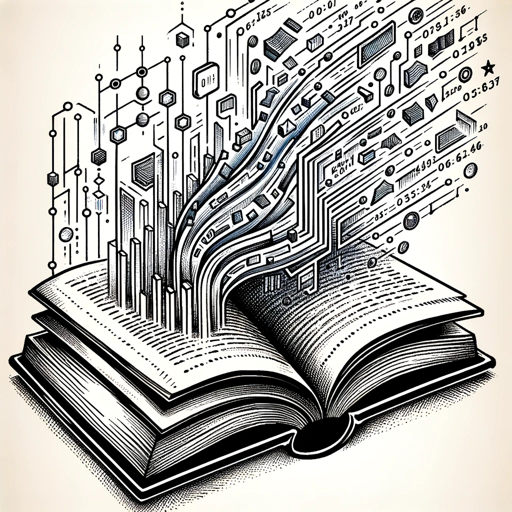Text Mining-text mining tools for insights
AI-powered insights from text data
How to use text mining.
Explain the basic concepts of text mining.
Related Tools
Load MoreThematic Analysis Assistant
Thematic Analysis on Textual Documents

Text Analysis
A text analysis assistant for better reading comprehension.

Ex-Act
Use "SHORTS" for concise texts, easy learning, memorizing & applying *** use "QUIZ" for a quiz *** use "REVIEW" for a critical review *** Update: 2024-03-25

Content Analysis Pro
Automated text analysis tool for qualitative data.

Text Expert
Text refinement specialist

AI Text Analyzer
Quick, clear analysis on AI or plagiarized texts with reliability estimates.
20.0 / 5 (200 votes)
Introduction to Text Mining
Text mining refers to the process of extracting meaningful information from unstructured text data through various computational techniques. The primary purpose of text mining is to transform large volumes of text into valuable insights, aiding in decision-making and knowledge discovery. Text mining is extensively used in fields such as business intelligence, social media analysis, academic research, and customer sentiment analysis. For example, companies may analyze customer reviews to understand product perception, while researchers might use text mining to explore trends in academic publications.

Key Functions of Text Mining
Sentiment Analysis
Example
Analyzing customer reviews on e-commerce platforms to gauge overall sentiment towards a product.
Scenario
A retail company could use sentiment analysis to monitor and improve customer satisfaction by identifying common complaints and praises in product reviews.
Topic Modeling
Example
Discovering underlying themes in a collection of research papers.
Scenario
An academic institution might use topic modeling to understand the evolution of research areas over time and to identify emerging fields of study.
Named Entity Recognition (NER)
Example
Extracting names of people, organizations, and locations from news articles.
Scenario
A news agency could apply NER to automatically categorize and link articles based on the entities they mention, improving the organization and retrieval of news content.
Ideal Users of Text Mining
Businesses and Enterprises
Businesses benefit from text mining by gaining insights into customer preferences, improving marketing strategies, and optimizing product development. For instance, analyzing social media posts and reviews helps companies to respond quickly to consumer trends and maintain a competitive edge.
Researchers and Academics
Researchers use text mining to analyze large volumes of academic literature, identify research gaps, and explore new areas of study. Text mining enables academics to systematically review existing research, uncover trends, and generate hypotheses based on the analysis of scholarly texts.

Steps to Use Text Mining
Visit aichatonline.org
For a free trial without login, also no need for ChatGPT Plus. This platform offers comprehensive tools for text mining that you can start using immediately.
Prepare Your Data
Ensure your text data is clean and well-structured. Text mining works best with pre-processed data, where noise like irrelevant words and special characters is minimized.
Select a Text Mining Tool
Choose the appropriate text mining tool or algorithm based on your needs, such as sentiment analysis, topic modeling, or keyword extraction. Tools like R, Python, or specialized platforms like RapidMiner can be used.
Analyze the Text Data
Apply the selected algorithm to your text data. Monitor the process and adjust parameters as needed to ensure optimal results.
Interpret and Visualize Results
Once analysis is complete, use visualization tools to interpret the results. Graphs, word clouds, and heatmaps can help in understanding patterns and insights from the text data.
Try other advanced and practical GPTs
Laravel Monkey
AI-powered Laravel Debugging and Optimization.

FiveM RedM Specialist
Enhance your FiveM/RedM experience with AI-powered insights.

FiveM Dev Companion
AI-powered assistant for FiveM development.

Fiverr Guide
Empowering Fiverr freelancers with AI insights

FiveM Lua GPT [ESX/QBCORE/OX]
AI-powered FiveM scripting assistant
![FiveM Lua GPT [ESX/QBCORE/OX]](https://files.oaiusercontent.com/file-YRZVcAwKuafoViU5QKY7yeAY?se=2123-12-26T07%3A27%3A08Z&sp=r&sv=2021-08-06&sr=b&rscc=max-age%3D1209600%2C%20immutable&rscd=attachment%3B%20filename%3Dfivem.png&sig=3IzZ85Y%2B%2Bv/Z5pLsF6HKWRENvsKr2CIv%2BhaFeNUyI14%3D)
Business Plan and Financial Projections Assistant
AI-Powered Precision for Business Success

Data Mining Tutor 2
AI-powered data mining tutor for students.

SARMS Goblin
AI-Driven Insights for SARMs Usage

Windows 11 Whiz
AI-powered Windows 11 assistance

Job Journey - The Resume Generator
AI-powered resume creation tailored for your job hunt.

UX Design and Research. ai
AI-powered UX design and research.
The Polymath
AI-Powered Insight for Every Query.

- Social Media
- Academic Research
- Healthcare
- Sentiment Analysis
- Customer Feedback
Detailed Q&A on Text Mining
What is Text Mining?
Text mining is the process of extracting meaningful information from unstructured text data through various techniques like natural language processing (NLP), machine learning, and statistical methods. It’s widely used in fields such as marketing, finance, and academic research.
How is Text Mining different from Data Mining?
While data mining involves finding patterns in structured data, text mining focuses on unstructured text data. Text mining techniques are designed to handle the complexities of human language, such as context, ambiguity, and syntax.
What are common applications of Text Mining?
Common applications include sentiment analysis for understanding customer opinions, topic modeling for identifying themes in large text corpora, and document classification for organizing large sets of text data.
What tools are commonly used in Text Mining?
Popular tools include Python libraries like NLTK and SpaCy, R packages like tm and quanteda, and platforms such as RapidMiner and KNIME, which provide a graphical interface for performing text mining without coding.
What are the challenges in Text Mining?
Challenges include handling the vast variety of language nuances, dealing with unstructured data, and requiring significant preprocessing. Additionally, creating accurate models can be difficult due to the subjective nature of human language.